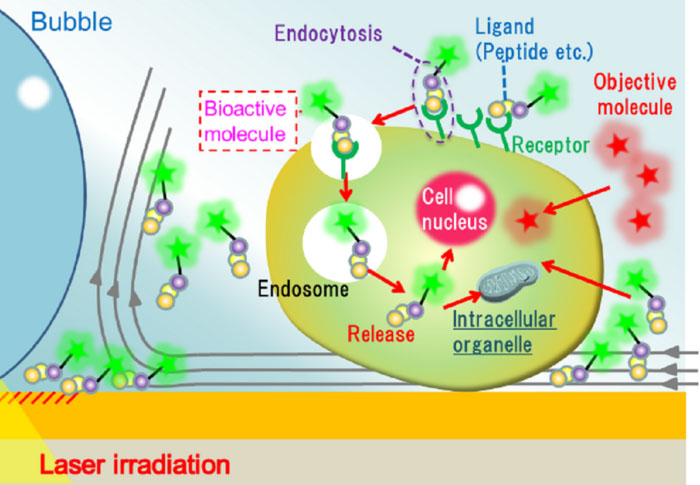| Mar 06, 2023 |
Light-induced acceleration of intracellular delivery
|
|
(Nanowerk News) Cell membranes are barriers that maintain cellular homeostasis, and the intracellular delivery of biologically functional molecules, including peptides, proteins, and nucleic acids to manipulate cellular functions.
|
|
Conventional intracellular uptake processes require high concentrations of biofunctional molecules with low permeability to pass through the cell membrane. This results in low drug activity because the probability of the biofunctional molecules entering target cells and their organelles is low.
|
|
In addition, many drugs damage healthy cells as well as the cells that are supposed to target due to poor selectivity, making it necessary to develop technology that can increase drugs’ selectivity so that they enter targeted cells with high efficiency.
|
|
A research group led by Professor Ikuhiko Nakase (Assistant Director) and Professor Takuya Iida (Director) of the Research Institute for Light-induced Acceleration System (RILACS) at Osaka Metropolitan University used light-induced convection with the aid of superradiance to achieve enhanced permeability of the cell membrane, by locally concentrating biofunctional molecules, including cell-penetrating peptides (CPPs). The light-induced system was capable of effective drug delivery, even at concentrations as low as 1 pmol/L.
|
|
The research has been published in Nano Letters ("Light-induced condensation of biofunctional molecules around targeted living cells to accelerate cytosolic delivery").
|
 |
| Light-induced accelerating system to increase the concentration of biofunctional molecules around targeted cells and their cytosolic delivery. (Image: Ikuhiko Nakase, and Takuya Iida, OMU)
|
|
To induce photothermal assembly around live cells in cell culture medium, an infrared laser using a 10x objective was focused for one-hundred seconds on the bottom of a glass dish densely coated with gold nanoparticles; the laser’s wavelength is hardly absorbed by living organisms and does not cause damage but can generate heat and a photothermal flow. Molecules were concentrated near a bubble generated by the laser heat, which was located approximately 100 µm away from the target cells on the substrate.
|
|
Using this system, the group found that around the laser irradiation point, mitochondrial structures near the photo-induced bubbles were efficiently stained even at a concentration 0.1% of that of conventional methods. Furthermore, the light-induced acceleration succeeded in inducing apoptosis using CPPs at a concentration 1% of that of conventional methods, resulting in extremely efficient and selective cellular uptake that resulted in the destruction of targeted cancer cells.
|
|
“Developing technologies that can selectively introduce biofunctional molecules into targeted cells is important, not only for basic research but also in clinical practice. We expect these results will significantly reduce the concentration of drugs needed to perform cell testing. Because new drugs are often expensive to manufacture, this will lower costs—and speed up drug discovery. Furthermore, we will apply these results to medical technologies that can contribute to cancer diagnosis and treatment and strive to make this technology useable in human healthcare,” concluded Professor Nakase and Professor Iida in a joint statement.
|

